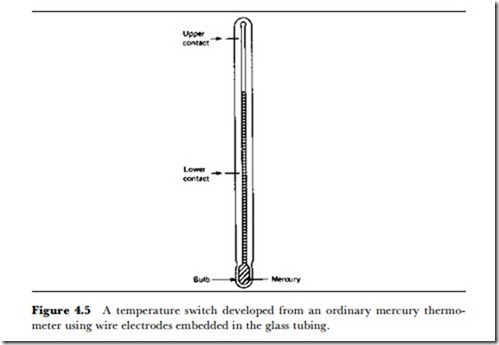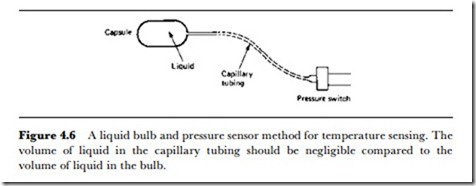Liquid and gas expansion
An older principle used in temperature sensing is liquid expansion in con- junction with a pressure switch, making use of the principles of the familiar mercury thermometer. The simplest sensor of this type is an adaptation of a mercury thermometer with two wire electrodes inset into the capillary (Figure 4.5). Since mercury is a conducting metal, a circuit will be made through the electrodes when the mercury level reaches the electrode whose
Figure 4.5 A temperature switch developed from an ordinary mercury thermo- meter using wire electrodes embedded in the glass tubing.
position corresponds to the higher temperature. This allows a predetermined temperature to be sensed, but for a switching action only and with no way of altering the temperature at which switching takes place other than by replacing the sensor with another one.
Although the mercury level can be used to change the frequency of an oscillating circuit and thus to provide a proportional sensing of temperature, this type of action is seldom used. The sensors that are used for temperature measurement as distinct from switching are mainly of the electronic type, including thermocouples and thermistors, and devices that make use of mechanical expansion are more likely to be used in switching circuits. The most common type is a development of the conventional bulb thermometer and has a sensing element (Figure 4.6) consisting of a capsule filled with liquid that is connected by a narrow-bore tube to the pressure switch. The liquid need not be mercury, and is nowadays more likely to be a form of synthetic oil.
Since the capsule can be remote, and involves no electrical connections, this is often a very useful method to use for hazardous environments, and the liquid can be chosen accordingly. The length of connecting tubing must be such that the volume of liquid contained in the tubing is only a small fraction of the total volume, since the temperature of the liquid in the tubing will also affect the pressure. The use of air or an inert gas in place of a liquid makes the device very much more sensitive, but the pressure switch needs to be able to respond to much lower pressures than are exerted by an expanding liquid.
One disadvantage of the system in general is that the sensing capsule needs to contain a reasonable volume of liquid and so cannot be small. In addition, since this volume of material has to be heated and cooled in order to follow temperature fluctuations, time is needed for the change, so that capsules cannot follow rapidly changing temperatures. The pressure sensor need not be a switching device, and the use of a diaphragm coupled to a potentiometer, LVDT or piezoelectric transducer can make the liquidjbulb type of temperature sensor into a fairly precise instrument, although this combination has few applications.

